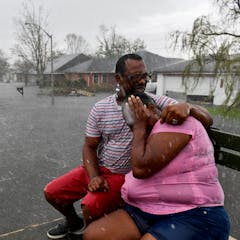
Articles on Extreme rainfall
Displaying 1 - 20 of 41 articles

Weather forecasting is improving at a great rate, even though climate change could be making it tougher.

These giant rivers in the sky are both destructive and essential for the Western U.S. water supply.

We all know climate change makes extreme weather more likely. But it’s also loading the dice for quick-forming drought, sudden and intense rainfall and fast-forming tropical storms.

A hurricane scientist explains the conflict between 2023’s abnormally high ocean heat and the storm-disrupting wind shear accompanying El Niño.

Even ‘climate havens’ face a riskier future, and infrastructure often isn’t built to handle climate change. But there are steps cities can take to prepare.

More extreme rainfall and frequent storms are raising the risk that floodwaters could spill over dams, or that dams could fail.

Parts of New York’s Hudson Valley were hit with 10 inches of rain, and the mountains of Vermont – where runoff can quickly turn deadly – saw some its worst flooding since Hurricane Irene.

Some were quick to point the finger at climate change when floods hit eastern Australia in February and March 2022, in the lead up to the federal election. But it’s not that simple, scientists say.

Nationally, 57% of the population says they’re not prepared for a flood disaster. Surveys and disasters show that those most at risk are least prepared.

Building too close to cliffs and slopes, weak soils, lack of vegetation and increased rainfall all played a part in the massive storm damage to Auckland. The city needs to change the way it uses land.

High intensity rain has actually increased, which is topping up underground water stores.

A climate scientist explains the forces behind the summer’s extreme downpours and dangerous heat waves, and why new locations will be at risk in the coming year.

Extreme downpours caught people off guard from Las Vegas to Kentucky in July 2022.

While surface temperatures were about the 6th warmest on record in 2021, the upper oceans were at their hottest – and they’re a stronger indicator of global warming. A top climate scientist explains.

A hurricane that wreaked havoc from Louisiana to New York City, the Texas freeze and devastating western wildfires topped NOAA’s list of billion-dollar disasters in 2021.

US disasters in 2021 told a tale of two climate extremes. A climate scientist explains why wet areas are getting wetter and dry areas drier.

Shoreline communities are already faltering under the weight of billions of dollars in damages — and worrying that climate change will continue to make things even worse.

Southern Québec is warming twice as rapidly as the rest of the world due to the progressive loss of snow cover. An average annual warming of 3 C to 6 C is expected by the end of the century.

Evidence is mounting that, as the climate warms, the amount of rain falling in heavy storms is increasing, especially in the central and eastern US.

A new attribution study finds human-caused climate change made Europe’s July floods more likely. What about Tennessee’s flooding? An atmospheric scientist explains how scientists make the connection.
